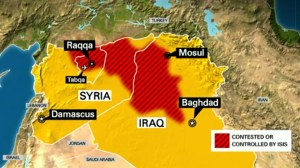American jets began bombing ISIS targets in Syria early Tuesday, raising U.S. involvement in the war-torn country and sending a forceful message to the terror group.

The airstrikes focused on the ISIS stronghold of Raqqa, a U.S. official told CNN, though other locations were hit as well.
At least 20 targets in an around Raqqa were hit, the opposition group Syrian Observatory for Human Rights said.
They’re the first strikes against the terror group inside the country since President Barack Obama’s announcement this month that he was prepared to expand the American efforts beyond targets in Iraq.
All foreign partners participating in the strikes with the United States are Arab countries, a senior U.S. military official told CNN. Those nations are Bahrain, Saudi Arabia, the United Arab Emirates and Jordan.
Diplomatic sources told CNN that Qatar was also involved, though it was not clear whether Qatar actually conducted airstrikes itself.
The U.S. and “partner nation forces” began striking ISIS targets using fighters, bombers and Tomahawk missiles, Pentagon spokesman Rear Adm. John Kirby said, though he didn’t specify a geographic location.
Citing the ongoing operations, Kirby said the Pentagon would not provide additional details immediately. But a U.S. military official said the strikes are meant to target the ability of ISIS to command and control, resupply and train.
Tomahawk missiles launched from the sea initiated the strike, followed by bombers and fighters, a senior U.S. military official told CNN.
The goal with this first move is to have an initial, definitive blow, the official said, describing the pace of the operation as intense.
Most of the spots hit were hard targets such as buildings, a senior U.S. official told CNN.
A post office, a recruitment center and a building in the governor’s compound were among the structures in Raqqa hit by U.S. airstrikes, Syrian opposition activists said.
There was no immediate word about casualties, the activists said.
Power went out in the city shortly after the airstrikes but was restored later Tuesday morning.
A ‘punch in the nose’
Until now, ISIS has been able to take over cities and operate in Syria with near impunity. Now, it’s coming under attack.
“This is the punch in the nose to the bully that we talked about on the playground,” former Delta Force officer James Reese said. “ISIS is the bully, and we just punched him in the nose.”
With the airstrikes, the United States enters a new level of engagement in the ongoing Syrian civil war. Obama had resisted U.S. military action in Syria, but as the Islamic State in Syria and Iraq made sweeping advances in both Middle Eastern neighbors, calls for such a step grew.
“I have made it clear that we will hunt down terrorists who threaten our country, wherever they are,” Obama said in a September 10 speech. “That means I will not hesitate to take action against ISIL in Syria, as well as Iraq. This is a core principle of my presidency: if you threaten America, you will find no safe haven.”
The message of the speech was clear — it was a matter of when, not if — the United States would carry out airstrikes inside Syria.
A U.S. intelligence official said that while law enforcement is aware the airstrikes against ISIS in Syria could incite a response, there is no evidence to suggest any terrorist strike is in the works against the United States.
Last week, U.S. officials told CNN that the military had everything in place it needed to strike ISIS inside Syria and was awaiting Obama’s go-ahead to do so.
For weeks, intelligence and military targeting specialists have been working around the clock on a list of targets, the officials said. It is unlikely that the President reviewed all the targets individuall, but was presented broad guidance with analysis about the risks of bombing inside Syria, as well as the rewards in terms of attacking ISIS.
Secretary of Defense Chuck Hagel told the House Armed Services Committee last week that he and Chairman of the Joint Chiefs of Staff Gen. Martin Dempsey signed off on plans to strike ISIS in Syria.
“CENTCOM’s plan includes targeted actions against ISIL safe havens in Syria — including its command and control, logistics capabilities, and infrastructure,” Hagel said last week. “Our actions will not be restrained by a border that exists in name only.”















